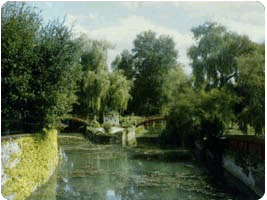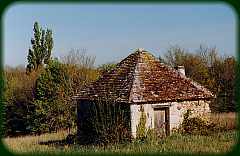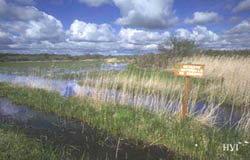The Natural History of the region |
|
The area around the house and barn is rich in flora and fauna. The barn has a resident Barn Owl and many bats. The longere has a breeding Beech Marten, Black Redstarts and Swallows and the beif [millstream] has Kingfishers and Muskrats. The land around the house has Orchids [including Lizard] and the Deptford Pink. The field and valley play host to many raptors including our resident Barn Owl [who will be heard screeching her way across at night], Little Owl, Kestrel, Buzzard and Montagu's Harrier. The river [and the bief], have trout, mayflies and Emerald Damsonflies. Visit the photo gallery.
Le
Grand-Pressigny The district around le Grand-Pressigny is wooded and cut by several rivers : the Claise, and its tributaries the Aigronne [which runs past our field], the Brignon, and the Muanne and it is bounded by the Creuse. The low-hilled, rolling countryside is on a flinty, chalky clay soil [ with chalk at the surface in many parts]. This allows for a rich, alkaline loving flora with many species that are rare in both France and the UK. The area has, for example, 33 different species of Orchid [including Lizard, Man and Burnt] La
Brenne Created in late 1989, it regroups 46 "communes" (parishes) with 30000 inhabitants within a mixed syndicate that includes the "région Centre" and the department of Indre administrations. The Brenne is one of the most important areas of "étangs" in France. An internationally important wetland, it harbours natural habitats and species of wild plants and animals that are threatened. At the limit of Berry (departments of Indre and Cher), and at the edge of the Poitou, Limousin and Touraine regions, the Brenne parc naturel régional covers some 160 000 ha where we find 30 000 inhabitants. It comprises a group of varied natural areas of which the most characteristic is the region of lakes. The lakes of Brenne : a real mosaic of habitat types, where water, woodland, heaths and meadows (sometimes dominated by the red sandstone "buttons") mix to provide for a particularly ecologically rich area. The Brenne is one of Frances' most important inland wetlands. The "Petite Brenne" and the Boichaut hedgerows : there are still a few man- made lakes here but the area is far more undulating and extensively covered with forest, it's a countryside of hedge-rimmed fields, used for sheep rearing. The Creuse and Anglin valleys : characterized downstream of Le Blanc (on the Creuse) and Ingrandes (on the Anglin) by the presence of limestone cliffs, further upstream the valleys are more open, their sloping sides wooded. Along their length are châteaux, abbeys and water mills. Around
Le Blanc : the richer soils here are favourable for cereals, with
stands of fruit trees (walnut, cherry...), with vineyards and market
gardens here and there. This is the area of "appellation d'origine
controlée" (a sort of quality control label) of the
pouligny-saint-pierre goat's cheese. Within the Parc there are very many species of insect, especilly dragonflies. Within the forests are Red and Roe deer, and Wild boar, in large numbers. No less rich, the plant life of Brenne, from orchids to centuries old oaks, vast reedbeds to heaths, may still hold many surprises.
|




